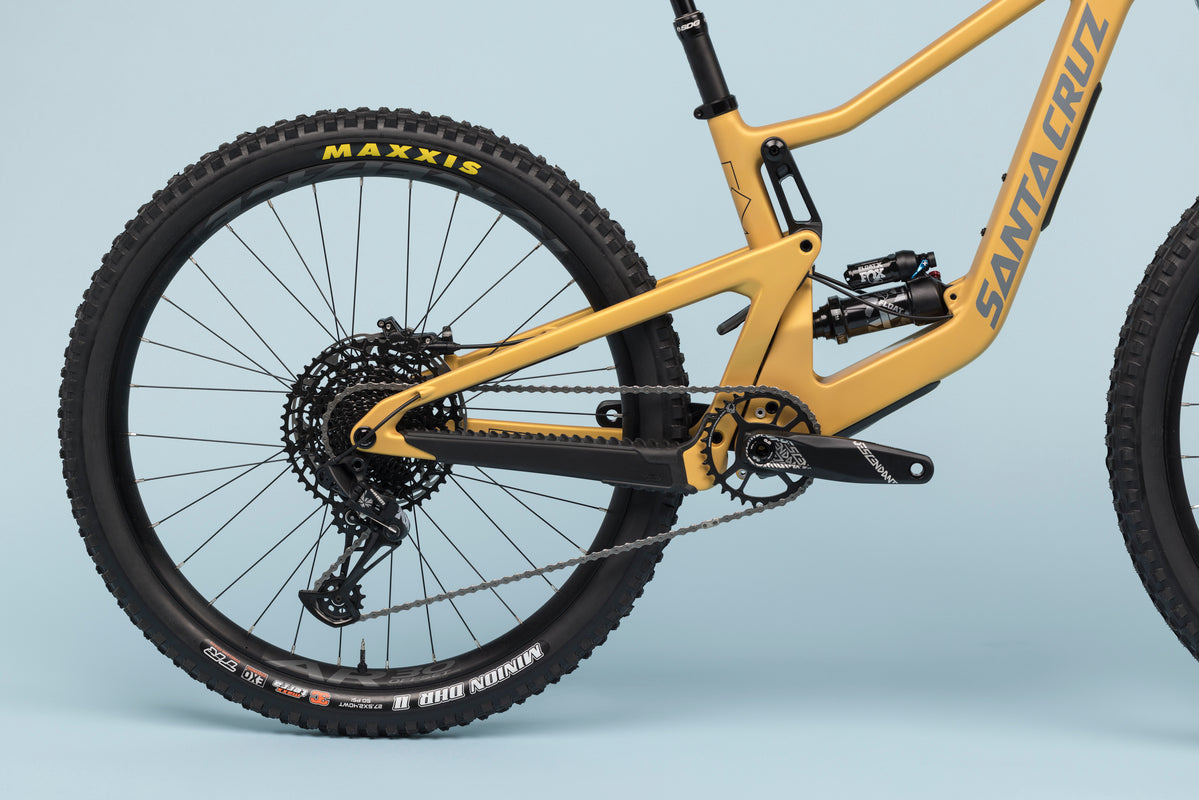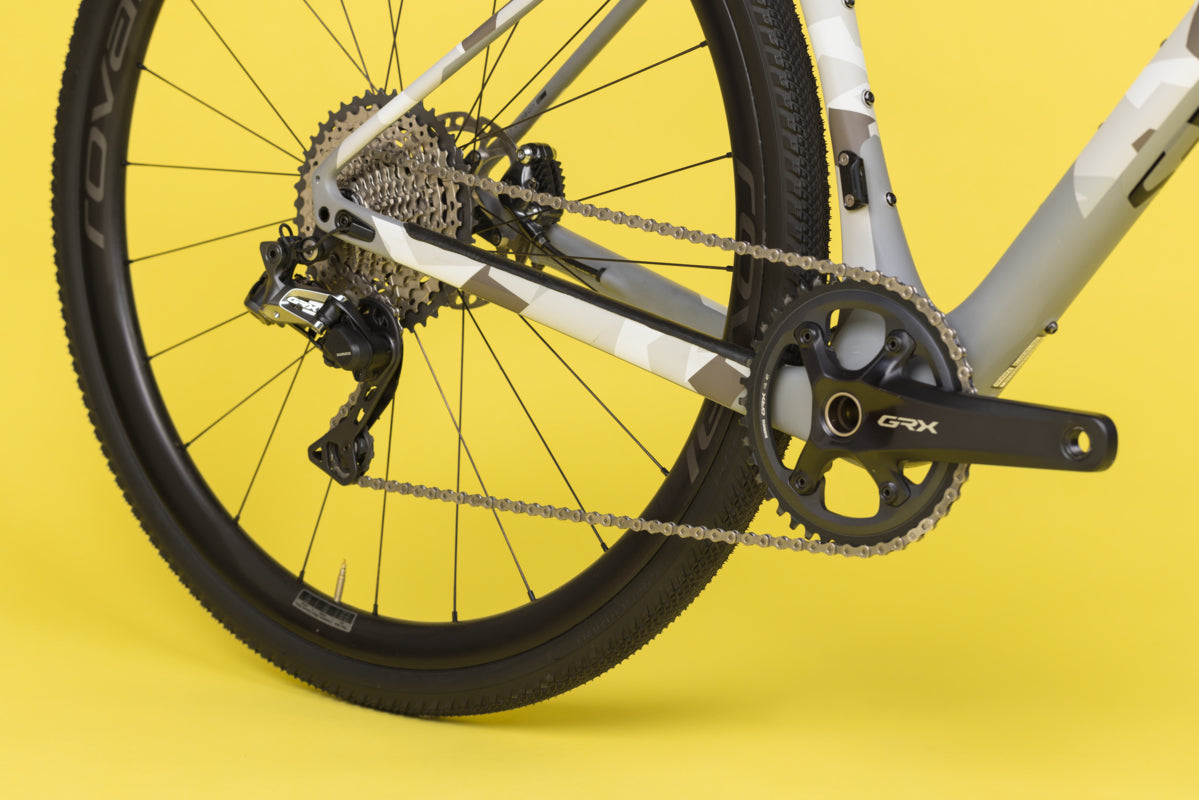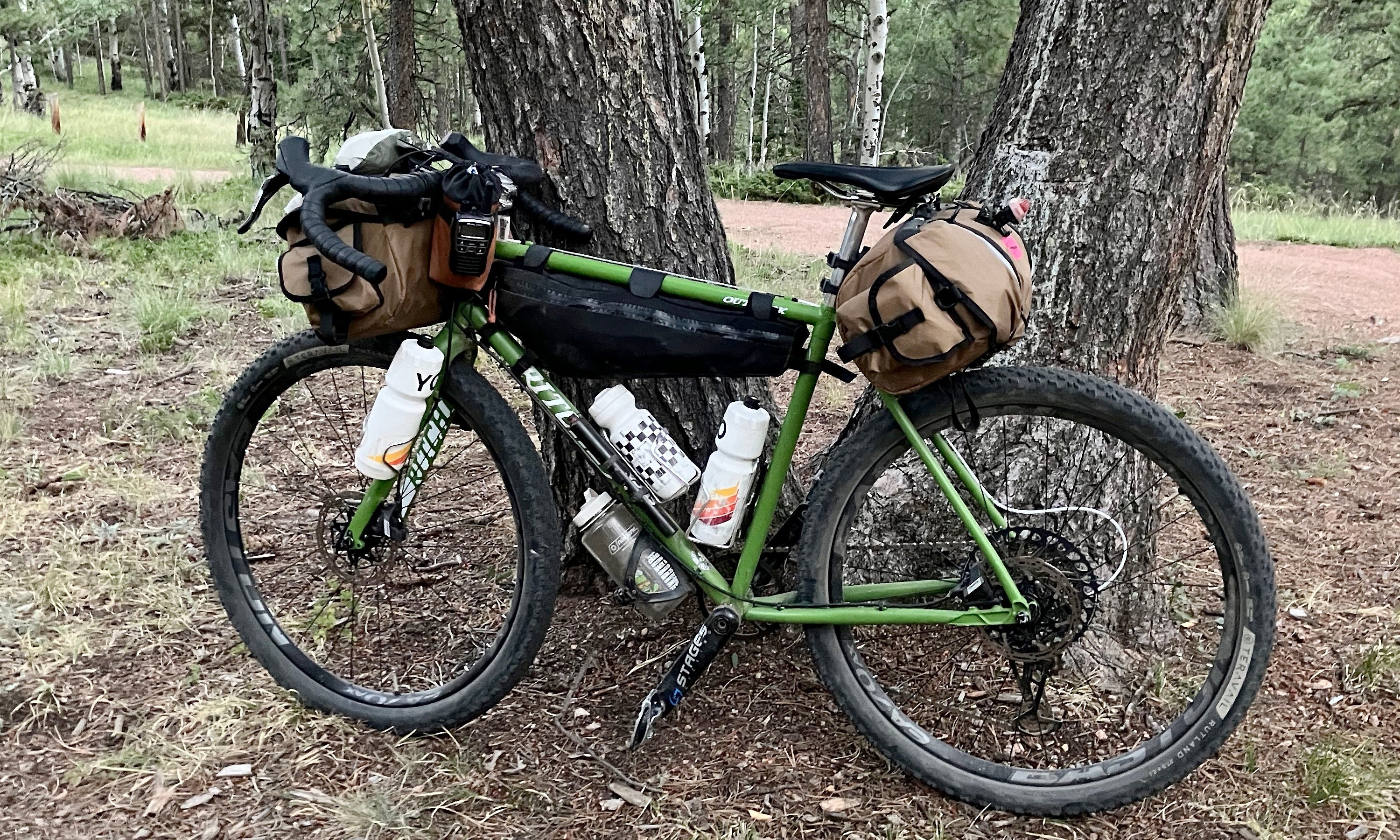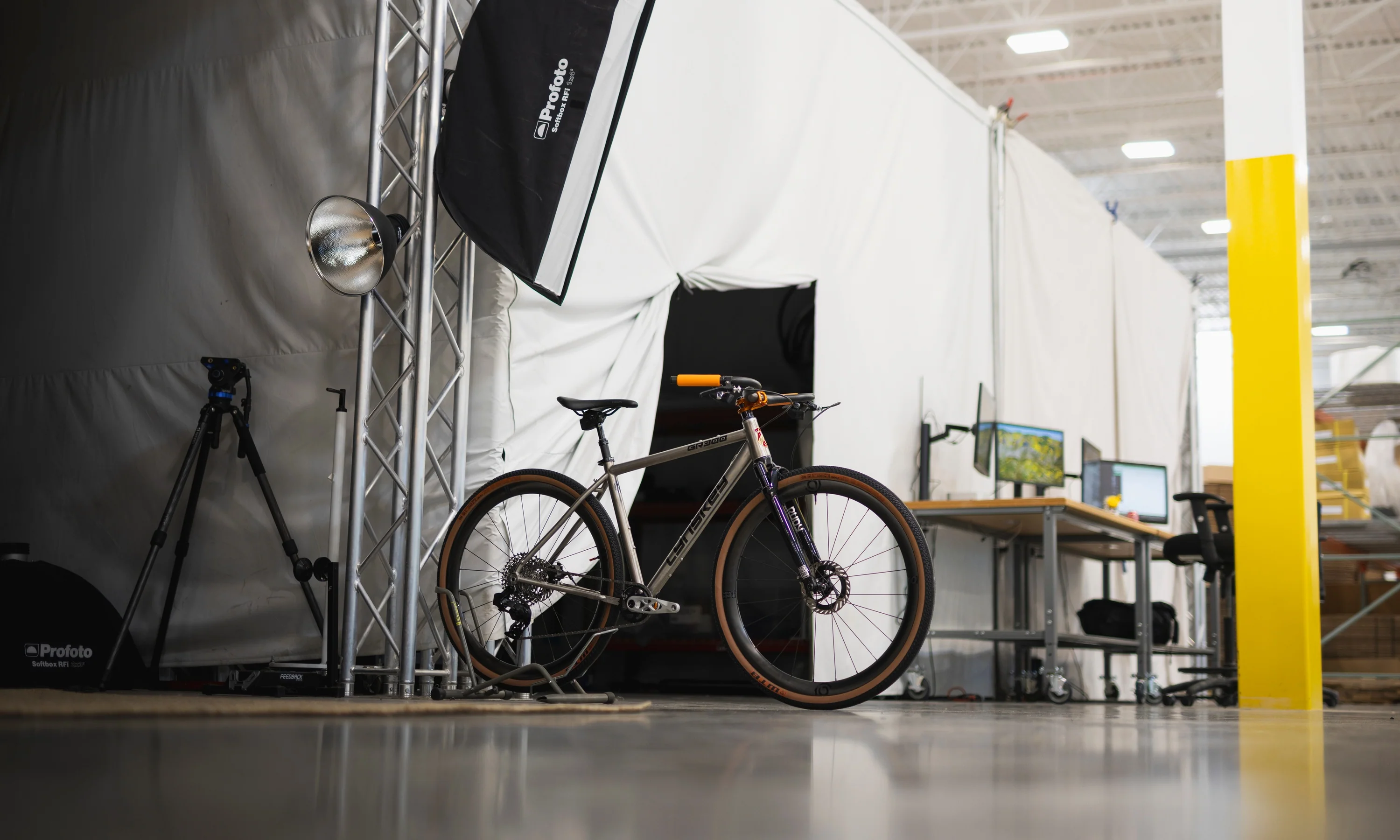Size matters, at least it does with 1x drivetrains. If you're anything like me, you spend a lot of (maybe too much) time thinking about your bike's gearing. Maybe you want an easier gear to crawl up steep climbs. Or maybe need a harder gear to hit higher speeds and stick to a fast group of riders.
1x drivetrains are all about finding the perfect compromise. Picking the right chainring size will give you the ideal range to for your local terrain and riding goals, allowing you to comfortably handle your toughest climbs and fastest descents. But how do you figure out what size chainring you need? Gear up with this easy guide.
What Are Standard MTB & Gravel Chainring Sizes?
1x chainrings come in 2-tooth increments and many 1x mountain bikes and gravel bikes will come from the factory with a “standard” size chainring. These sizes became standard because they mirror the size of the middle (and most used) chainring in older 3x drivetrains.
The good news is that 1x chainrings make it super easy to change your chainring to suit your needs. Some riders even keep a couple different sizes on hand so they can set their bike up for different rides!
Mountain bikes: 32t vs. 30t vs. 34t chainrings
 32t chainrings are generally considered "standard" and most bike companies will outfit their mountain bikes with 32t chainrings. There are some exceptions though. XC bikes made for high-speed racing may come with a slightly larger 34t chainring while heavier trail and enduro bikes may come equipped with smaller 30t chainrings.
32t chainrings are generally considered "standard" and most bike companies will outfit their mountain bikes with 32t chainrings. There are some exceptions though. XC bikes made for high-speed racing may come with a slightly larger 34t chainring while heavier trail and enduro bikes may come equipped with smaller 30t chainrings.
The assumption is that XC riders will want more top-end gearing for fast terrain. Enduro riders, on the other hand, might find themselves grinding up steep climbs on heavier and less efficient bikes, so they'd appreciate an easier gear. Plus, on many of the rough descents that aggressive trail and enduro bikes are designed for, you don't have to pedal all that often.

Browse New & Used Mountain Bikes
Shop CPO used mountain bikes at TPC - The Pro's Closet, including full-suspension, XC and enduro MTBs. Browse popular MTB brands like Trek, Specialized, Santa Cruz and more for the best mountain, road, and gravel bikes.
TPC - The Pro's Closet is the leader in buying and selling new and Certified Pre-Owned used bikes. With over 160,000+ customers served and 46,000 bikes sold. Talk to an expert Ride Guide today to find the right mountain bike for you.
Gravel bikes: 42t vs. 40t chainrings
 Chainring size is a bit less predictable on gravel bikes. Many brands opt for 42t rings as the standard. However, some choose a 40t for a slightly easier climbing gear. In general, gravel bikes designed for more rugged terrain often come with a smaller chainring. A more race-oriented gravel bike is likely to have at least a 42t chainring, if not something much bigger like a 44t or 46t.
Chainring size is a bit less predictable on gravel bikes. Many brands opt for 42t rings as the standard. However, some choose a 40t for a slightly easier climbing gear. In general, gravel bikes designed for more rugged terrain often come with a smaller chainring. A more race-oriented gravel bike is likely to have at least a 42t chainring, if not something much bigger like a 44t or 46t.
When should you try a smaller chainring for MTB and Gravel?
 The Queen of Pain, Rebecca Rusch, said she sized down her chainring to conquer the tough climbs at her namesake race. Photo by: Wyatt Caldwell / Redbull Content Pool
The Queen of Pain, Rebecca Rusch, said she sized down her chainring to conquer the tough climbs at her namesake race. Photo by: Wyatt Caldwell / Redbull Content Pool
Finding the perfect gearing for your bike might require a bit of experimentation. Hopefully, you already have a chainring on your bike that you can use as a starting point. If you're starting from scratch (e.g., you're building a new bike from the frame up) then the best place to start is one of the standard chainring sizes mentioned above.
If you have a stock chainring serving as your baseline, here's what you need to know:
If you need easier gearing for climbs, swap to a smaller chainring. Smaller chainrings are a good upgrade for riders who struggle with climbing, riders who regularly ride very steep terrain, or who need to carry extra weight with bike bags.
On a mountain bike, the small change of swapping from a 32t to a 30t chainring gives you a low gear that is 6.7% easier.
For gravel, going from a 42t to a 40t provides 5% easier gearing.
That could be the difference between conquering a steep climb and being forced to get off and walk. We like riding bikes, and successfully cleaning a climb is always more fun than hiking.
Mountain bike chainrings are often available in smaller sizes all the way down to 26t, though I recommend that most riders searching for an easy climbing gear should try a 30t or 28t chainring first.
For most gravel riders, I wouldn’t recommend going any smaller than 36-38t if you want to maintain top-end speed on flat roads and downhills. With smaller chainrings, you may find yourself spinning out on fast downhills.
That said, personally, I think the risk of spinning out is always preferable to being overgeared on climbs. Easier climbing gears keep my legs fresh and allow me to tackle ambitious rides. For regular riders, saving energy and preserving your knees through spinning, and completing tougher routes will improve the overall experience of riding.
Extra nerdy tip: On my full-suspension mountain bikes, I also like how the smaller chainring increases anti-squat, which firms up the rear end for efficient climbing. 30t is my go-to chainring size for steep Colorado climbs.
When should you switch to a bigger chainring?
 Pros like Nino Schurter (left) and Mathieu van der Poel can mash big 38t chainrings up climbs. We probably shouldn't copy them though. Photo by: Bartek Wolinski / Red Bull Content Pool
Pros like Nino Schurter (left) and Mathieu van der Poel can mash big 38t chainrings up climbs. We probably shouldn't copy them though. Photo by: Bartek Wolinski / Red Bull Content Pool
Bigger chainrings are great for riders who need more top-end speed or who ride mostly flat terrain. When using my 29er hardtail as a gravel bike, I swapped to a 36t chainring to keep up with drop-bar gravel bikes on flat roads. Look at pro MTB and gravel racers and you’ll see many using bigger chainrings. Many top male pros use 36-38t chainrings on XC mountain bikes and 46-48t chainrings on gravel bikes.
There are two main reasons high-level racers upsize chainrings. First, they are fitter and faster than the general population. Thus, they need to sustain higher speeds to compete with other riders at their level and they generally have no problem climbing with harder gears.
The second reason is more nuanced; 1x drivetrains are simple and reliable, but one of the major drawbacks is increased chain angle at the extremes of the cassette (the easiest and hardest gears). When the chain isn’t straight, there’s more friction, which leads to a slight efficiency loss.
Choosing a chainring that allows you to stay in the center of the cassette and maintain a straight chainline for most of your riding maximizes drivetrain efficiency.
For strong riders who are able to hold high average speeds, bigger chainrings can help them keep their chain in the middle of the cassette more often. Bigger chainrings also reduce friction because the chain doesn’t articulate as much when wrapping around it. Of course, you need to be strong enough to take advantage of these benefits. Most average riders are still better off with "standard" or smaller sized chainrings.
My advice: Unless you’re a pro or in the top 20% of riders, small efficiency increases probably don’t matter. You’re better off prioritizing climbing gears and using the smallest chainring possible.
Do You Need to Shorten or Lengthen Your Chain When Swapping Chainrings?
As a general rule, you can usually change the size of your chainring 2 teeth bigger or smaller without changing your chain length. If you go more than 2 teeth smaller, you might need to shorten your chain. More than 2 teeth bigger, and you'll need to add chain links or get a new, longer chain. 95% of the time, your rear derailleur will have enough b-gap or b-tension adjustment to compensate for a 2-tooth change. However, there are always edge cases.
You'll know your chain is too short if it pulls your rear derailleur into an extreme angle in the lowest gear. The rear derailleur will be pulled so tight that it is near horizontal and can no longer articulate. On full suspension mountain bikes, this can lead to poor suspension performance and even broken parts.
You'll know your chain is too long if it has too much slack in the chain when in the hardest gear. It will be loose, causing it to bounce around and hit your frame.
If you're unsure, check your chain length using the tips in our chain length/replacement tutorial.
Also, both of the above cases assume that your b-gap/b-tension is properly adjusted. You should check and adjust the b-gap/b-tension of your rear derailleur after changing the size of your 1x chainring. Fortunately, it's super easy.
Choosing the Best Chainring Size with a Gear Calculator
Gear calculators are a great tool if you want to compare different chainring options. To calculate the difference in gearing between 32t, 30t, 42t, and 40t chainrings, I used Sheldon Brown’s classic gear calculator. Seeing the difference as a percentage convinced me to try racing with a 30t chainring on my quiver-killer mountain bike.
Another favorite of mine is this HTML gear calculator. It provides a visual comparison of different drivetrains.
 In the above example, I compare a 1x drivetrain with a 42t chainring and 10-42t cassette to a compact road drivetrain. For gravel, I know a 42t chainring will work because it has a similar range to the compact while providing an easier low gear for climbing. If you have another drivetrain as a point of reference, this tool is great for finding the optimal 1x chainring for your needs. It also allows to figure out what your top-speed will be with different chainrings, which can help you decide if a chainring is too small for your needs.
In the above example, I compare a 1x drivetrain with a 42t chainring and 10-42t cassette to a compact road drivetrain. For gravel, I know a 42t chainring will work because it has a similar range to the compact while providing an easier low gear for climbing. If you have another drivetrain as a point of reference, this tool is great for finding the optimal 1x chainring for your needs. It also allows to figure out what your top-speed will be with different chainrings, which can help you decide if a chainring is too small for your needs.
In general, stock 32t and 42t chainring sizes are standard because they're pretty good for most riders. However, I think most riders would enjoy riding more with a smaller chainring. Don’t be swayed by macho racers pushing pie plate-sized rings. It may require some experimentation to find the perfect chainring for your bike set-up. Luckily they’re not too expensive, so try a few and find what works best for you!
What About The Best 1x Chainring Size for Road Bikes?
1x road bikes aren’t exactly common (yet), but there are plenty of riders out there experimenting with simplified drivetrains on their road bikes (including me). Take a look at some pro race bikes in the Tour de France and you'll see that two-time winner, Jonas Vingegaard, actually used a 1x road bike for several stages. 1x road bikes are only going to get more common.
Road bikes have the same chainring size options as 1x gravel bikes, but in general, road bikes will likely need a slightly larger 1x chainring than gravel bikes as they are often ridden at higher speeds.
If you already have experience riding a 1x gravel bike, I'd suggest starting with a chainring that is 2-4 teeth larger than what you are used to on your gravel bike. If you're starting from scratch, I'd consider starting out with a 46t chainring. If you have a modern 11 or 12-speed cassette with a 10t small cog, your top gear (46x10t) will be roughly between the top gear found on traditional compact (50x11t) and mid-compact (52x11t) road drivetrains.
Stronger riders and racers can consider trying a larger chainring in the 48-50t range. Jonas Vingegaard, who I mentioned above, uses a 50t chainring on his 1x road bike, but he's one of the strongest riders in the world. Unless you're primarily racing crits or flat courses, you'll likely need something a bit smaller.

























